Comprehensive Report: Proactive Health Safety and Wellbeing Management
VerifiedAdded on 2020/03/16
|13
|3556
|44
Report
AI Summary
This report provides a comprehensive overview of proactive health, safety, and wellbeing management within an organizational context. It emphasizes the critical importance of health and safety requirements, highlighting the employer's responsibility to safeguard employee health and well-being. The report introduces the concept of proactive health safety and wellbeing management, emphasizing its multidisciplinary nature and its goal of protecting employees from workplace hazards. It explores the purposes and motivations behind adopting a proactive approach, including reducing financial losses, improving human resource development, and enhancing control over potential threats. The report summarizes key drivers such as improving health and safety management, employee engagement, and overall business performance. It then delves into various approaches and models for proactive management, including RCMS, PDCA, and Singaporean standards such as SS506, CP 79, CONSASS, CultureSAFE, bizSAFE, and Total WSH & Wellbeing. The report concludes by highlighting key elements of effective proactive safety, health, and wellbeing management, such as visible senior management commitment and successful supervision.
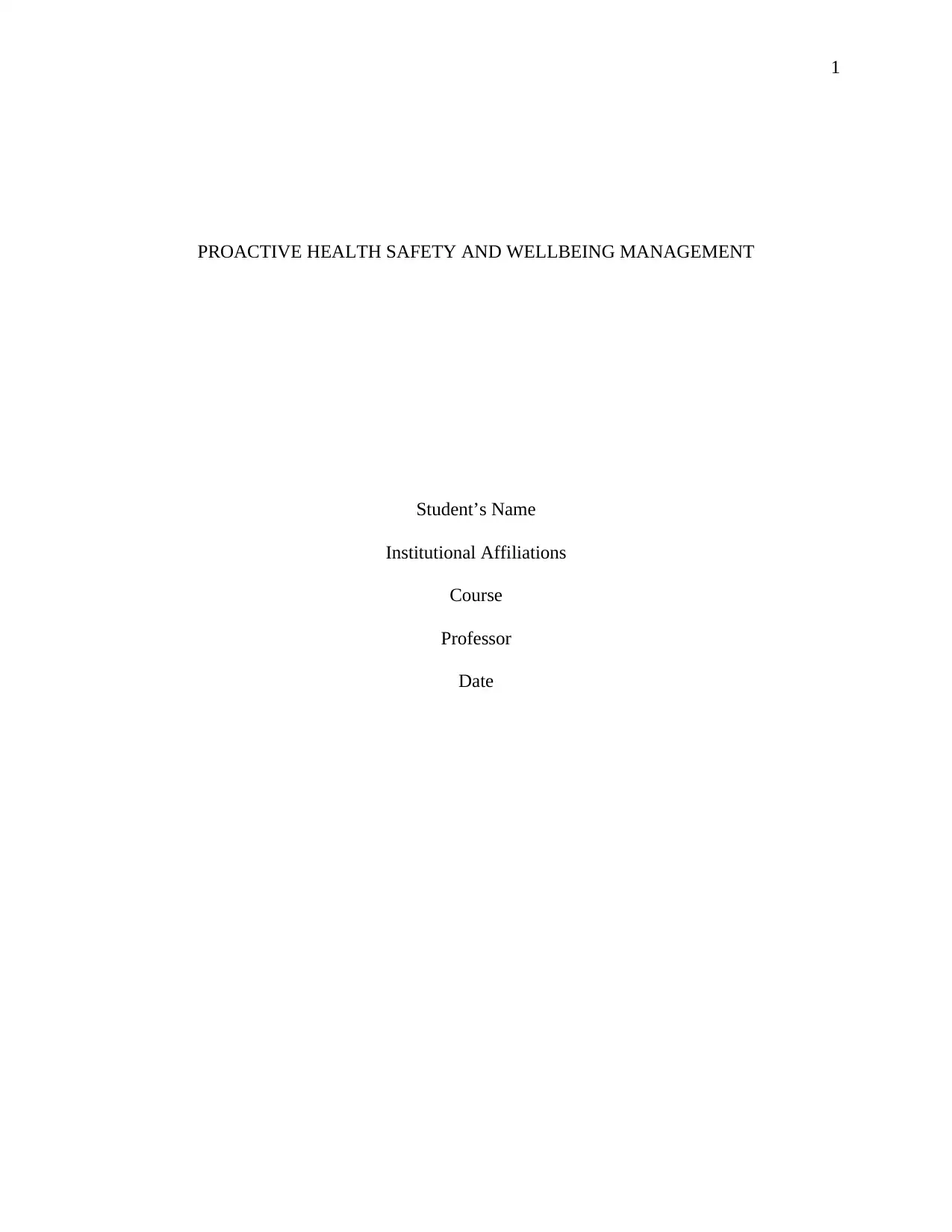
1
PROACTIVE HEALTH SAFETY AND WELLBEING MANAGEMENT
Student’s Name
Institutional Affiliations
Course
Professor
Date
PROACTIVE HEALTH SAFETY AND WELLBEING MANAGEMENT
Student’s Name
Institutional Affiliations
Course
Professor
Date
Paraphrase This Document
Need a fresh take? Get an instant paraphrase of this document with our AI Paraphraser
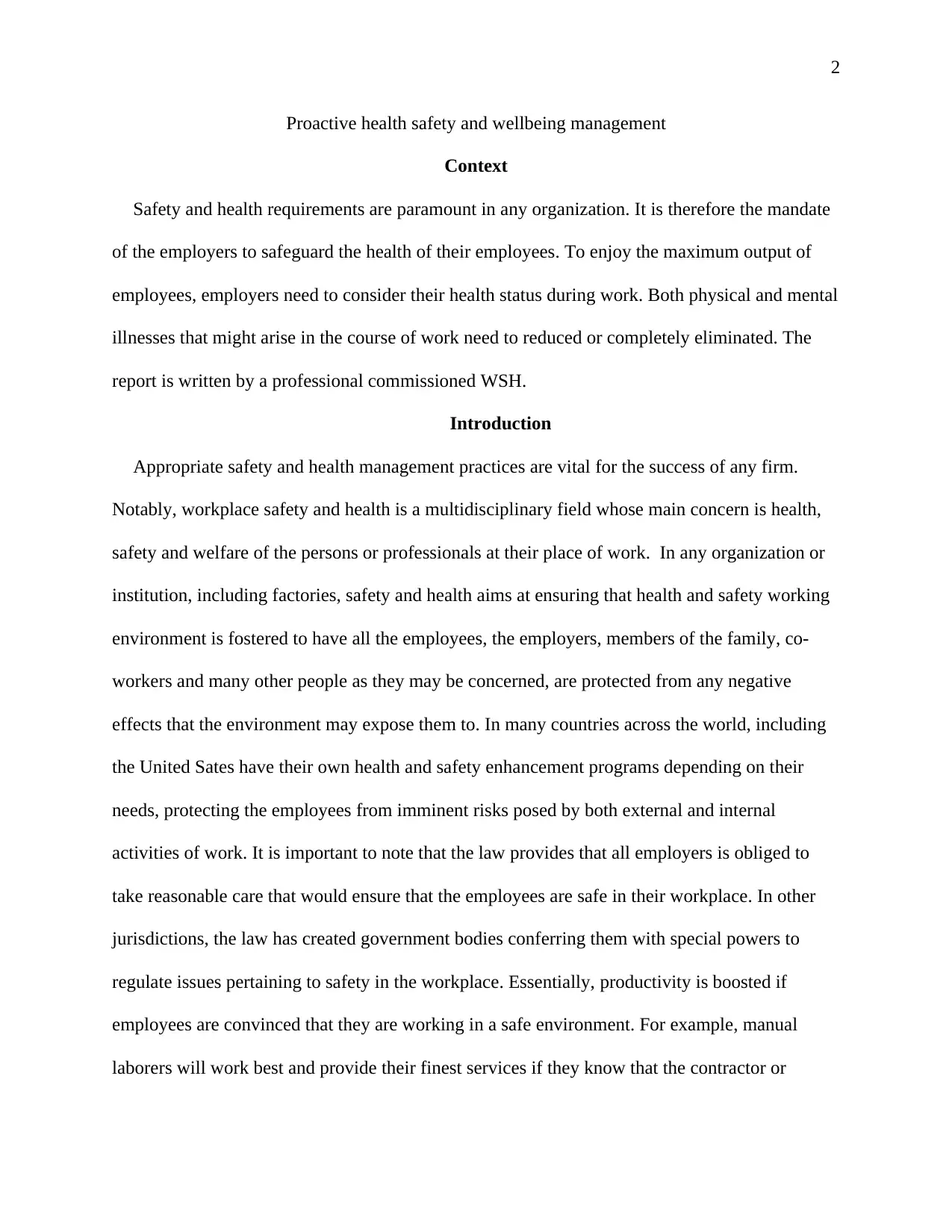
2
Proactive health safety and wellbeing management
Context
Safety and health requirements are paramount in any organization. It is therefore the mandate
of the employers to safeguard the health of their employees. To enjoy the maximum output of
employees, employers need to consider their health status during work. Both physical and mental
illnesses that might arise in the course of work need to reduced or completely eliminated. The
report is written by a professional commissioned WSH.
Introduction
Appropriate safety and health management practices are vital for the success of any firm.
Notably, workplace safety and health is a multidisciplinary field whose main concern is health,
safety and welfare of the persons or professionals at their place of work. In any organization or
institution, including factories, safety and health aims at ensuring that health and safety working
environment is fostered to have all the employees, the employers, members of the family, co-
workers and many other people as they may be concerned, are protected from any negative
effects that the environment may expose them to. In many countries across the world, including
the United Sates have their own health and safety enhancement programs depending on their
needs, protecting the employees from imminent risks posed by both external and internal
activities of work. It is important to note that the law provides that all employers is obliged to
take reasonable care that would ensure that the employees are safe in their workplace. In other
jurisdictions, the law has created government bodies conferring them with special powers to
regulate issues pertaining to safety in the workplace. Essentially, productivity is boosted if
employees are convinced that they are working in a safe environment. For example, manual
laborers will work best and provide their finest services if they know that the contractor or
Proactive health safety and wellbeing management
Context
Safety and health requirements are paramount in any organization. It is therefore the mandate
of the employers to safeguard the health of their employees. To enjoy the maximum output of
employees, employers need to consider their health status during work. Both physical and mental
illnesses that might arise in the course of work need to reduced or completely eliminated. The
report is written by a professional commissioned WSH.
Introduction
Appropriate safety and health management practices are vital for the success of any firm.
Notably, workplace safety and health is a multidisciplinary field whose main concern is health,
safety and welfare of the persons or professionals at their place of work. In any organization or
institution, including factories, safety and health aims at ensuring that health and safety working
environment is fostered to have all the employees, the employers, members of the family, co-
workers and many other people as they may be concerned, are protected from any negative
effects that the environment may expose them to. In many countries across the world, including
the United Sates have their own health and safety enhancement programs depending on their
needs, protecting the employees from imminent risks posed by both external and internal
activities of work. It is important to note that the law provides that all employers is obliged to
take reasonable care that would ensure that the employees are safe in their workplace. In other
jurisdictions, the law has created government bodies conferring them with special powers to
regulate issues pertaining to safety in the workplace. Essentially, productivity is boosted if
employees are convinced that they are working in a safe environment. For example, manual
laborers will work best and provide their finest services if they know that the contractor or
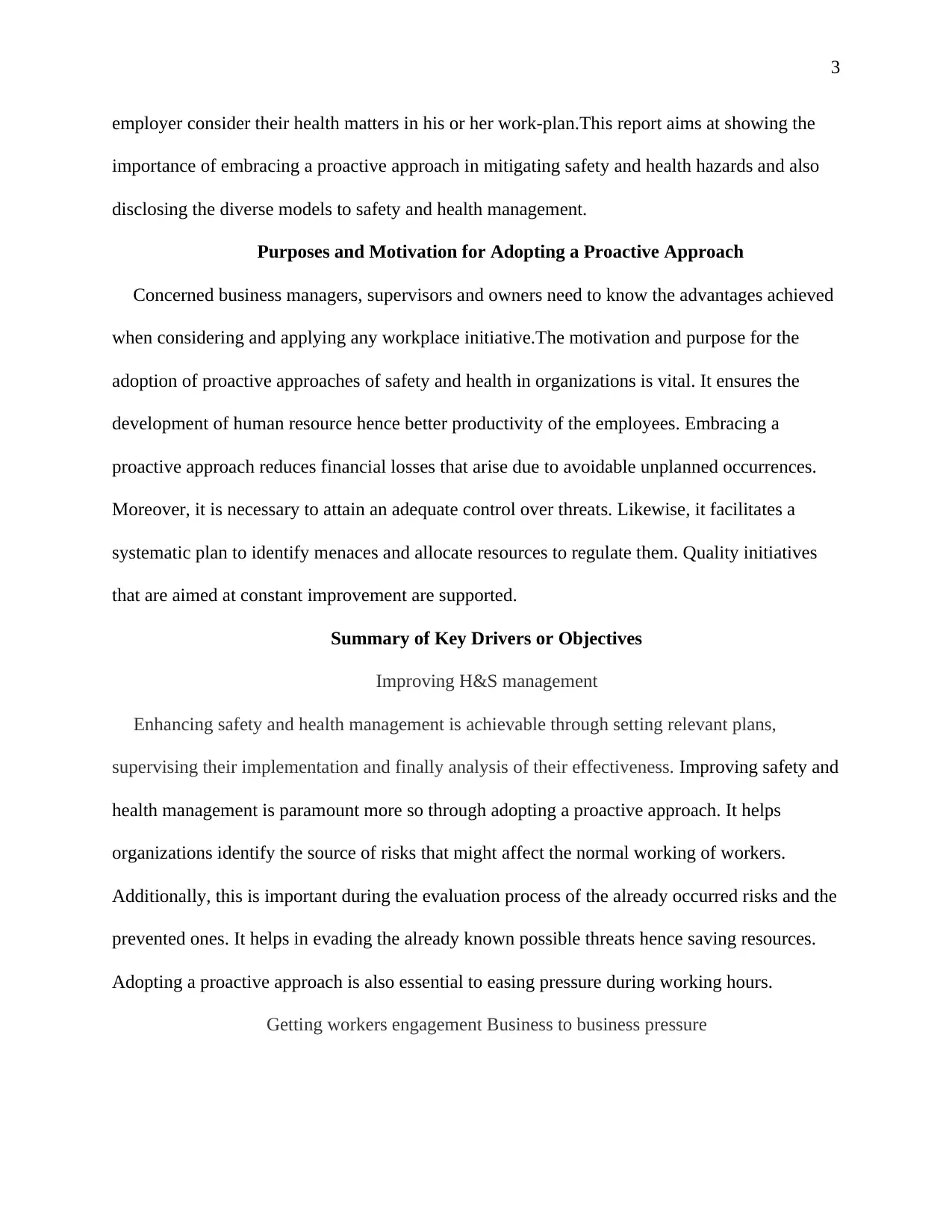
3
employer consider their health matters in his or her work-plan.This report aims at showing the
importance of embracing a proactive approach in mitigating safety and health hazards and also
disclosing the diverse models to safety and health management.
Purposes and Motivation for Adopting a Proactive Approach
Concerned business managers, supervisors and owners need to know the advantages achieved
when considering and applying any workplace initiative.The motivation and purpose for the
adoption of proactive approaches of safety and health in organizations is vital. It ensures the
development of human resource hence better productivity of the employees. Embracing a
proactive approach reduces financial losses that arise due to avoidable unplanned occurrences.
Moreover, it is necessary to attain an adequate control over threats. Likewise, it facilitates a
systematic plan to identify menaces and allocate resources to regulate them. Quality initiatives
that are aimed at constant improvement are supported.
Summary of Key Drivers or Objectives
Improving H&S management
Enhancing safety and health management is achievable through setting relevant plans,
supervising their implementation and finally analysis of their effectiveness. Improving safety and
health management is paramount more so through adopting a proactive approach. It helps
organizations identify the source of risks that might affect the normal working of workers.
Additionally, this is important during the evaluation process of the already occurred risks and the
prevented ones. It helps in evading the already known possible threats hence saving resources.
Adopting a proactive approach is also essential to easing pressure during working hours.
Getting workers engagement Business to business pressure
employer consider their health matters in his or her work-plan.This report aims at showing the
importance of embracing a proactive approach in mitigating safety and health hazards and also
disclosing the diverse models to safety and health management.
Purposes and Motivation for Adopting a Proactive Approach
Concerned business managers, supervisors and owners need to know the advantages achieved
when considering and applying any workplace initiative.The motivation and purpose for the
adoption of proactive approaches of safety and health in organizations is vital. It ensures the
development of human resource hence better productivity of the employees. Embracing a
proactive approach reduces financial losses that arise due to avoidable unplanned occurrences.
Moreover, it is necessary to attain an adequate control over threats. Likewise, it facilitates a
systematic plan to identify menaces and allocate resources to regulate them. Quality initiatives
that are aimed at constant improvement are supported.
Summary of Key Drivers or Objectives
Improving H&S management
Enhancing safety and health management is achievable through setting relevant plans,
supervising their implementation and finally analysis of their effectiveness. Improving safety and
health management is paramount more so through adopting a proactive approach. It helps
organizations identify the source of risks that might affect the normal working of workers.
Additionally, this is important during the evaluation process of the already occurred risks and the
prevented ones. It helps in evading the already known possible threats hence saving resources.
Adopting a proactive approach is also essential to easing pressure during working hours.
Getting workers engagement Business to business pressure
⊘ This is a preview!⊘
Do you want full access?
Subscribe today to unlock all pages.

Trusted by 1+ million students worldwide
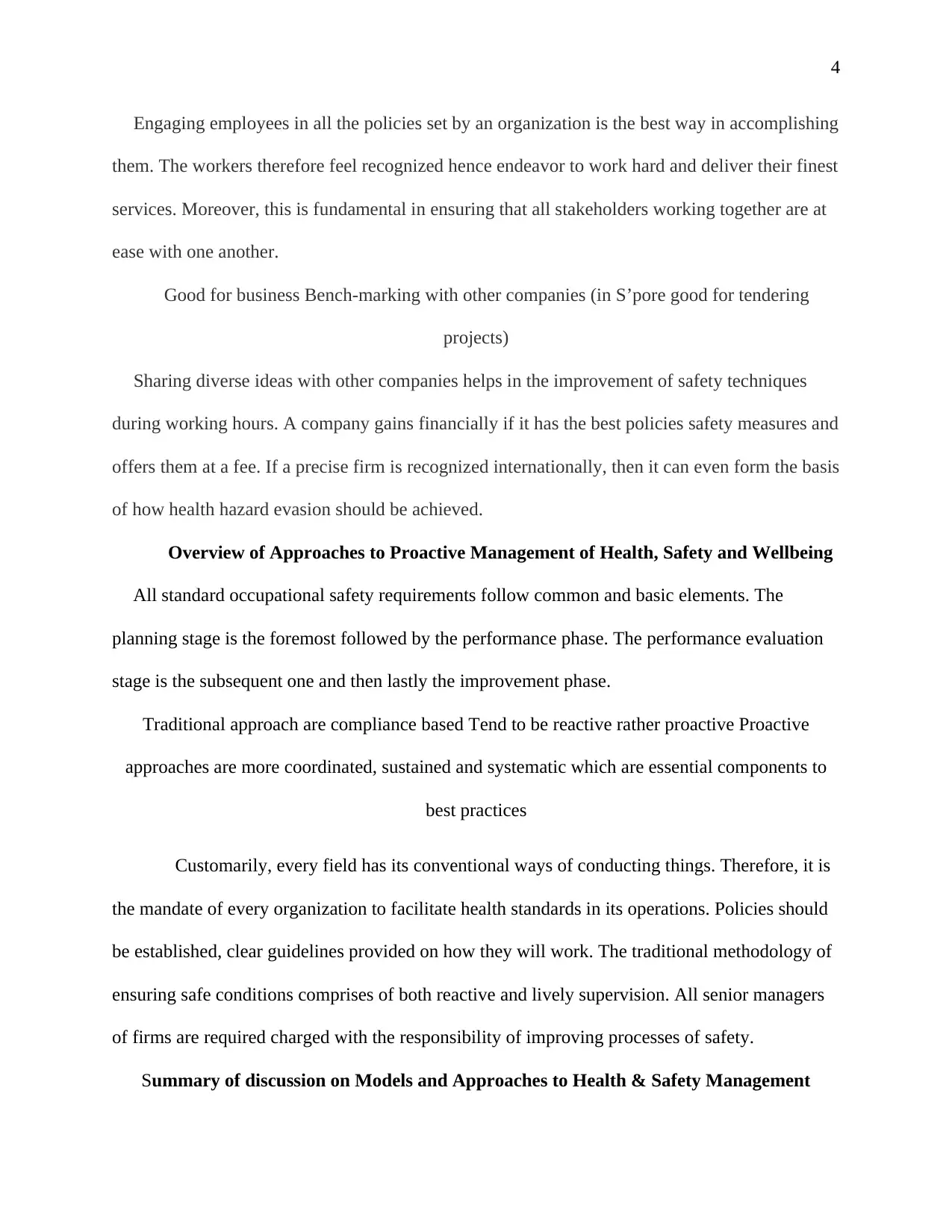
4
Engaging employees in all the policies set by an organization is the best way in accomplishing
them. The workers therefore feel recognized hence endeavor to work hard and deliver their finest
services. Moreover, this is fundamental in ensuring that all stakeholders working together are at
ease with one another.
Good for business Bench-marking with other companies (in S’pore good for tendering
projects)
Sharing diverse ideas with other companies helps in the improvement of safety techniques
during working hours. A company gains financially if it has the best policies safety measures and
offers them at a fee. If a precise firm is recognized internationally, then it can even form the basis
of how health hazard evasion should be achieved.
Overview of Approaches to Proactive Management of Health, Safety and Wellbeing
All standard occupational safety requirements follow common and basic elements. The
planning stage is the foremost followed by the performance phase. The performance evaluation
stage is the subsequent one and then lastly the improvement phase.
Traditional approach are compliance based Tend to be reactive rather proactive Proactive
approaches are more coordinated, sustained and systematic which are essential components to
best practices
Customarily, every field has its conventional ways of conducting things. Therefore, it is
the mandate of every organization to facilitate health standards in its operations. Policies should
be established, clear guidelines provided on how they will work. The traditional methodology of
ensuring safe conditions comprises of both reactive and lively supervision. All senior managers
of firms are required charged with the responsibility of improving processes of safety.
Summary of discussion on Models and Approaches to Health & Safety Management
Engaging employees in all the policies set by an organization is the best way in accomplishing
them. The workers therefore feel recognized hence endeavor to work hard and deliver their finest
services. Moreover, this is fundamental in ensuring that all stakeholders working together are at
ease with one another.
Good for business Bench-marking with other companies (in S’pore good for tendering
projects)
Sharing diverse ideas with other companies helps in the improvement of safety techniques
during working hours. A company gains financially if it has the best policies safety measures and
offers them at a fee. If a precise firm is recognized internationally, then it can even form the basis
of how health hazard evasion should be achieved.
Overview of Approaches to Proactive Management of Health, Safety and Wellbeing
All standard occupational safety requirements follow common and basic elements. The
planning stage is the foremost followed by the performance phase. The performance evaluation
stage is the subsequent one and then lastly the improvement phase.
Traditional approach are compliance based Tend to be reactive rather proactive Proactive
approaches are more coordinated, sustained and systematic which are essential components to
best practices
Customarily, every field has its conventional ways of conducting things. Therefore, it is
the mandate of every organization to facilitate health standards in its operations. Policies should
be established, clear guidelines provided on how they will work. The traditional methodology of
ensuring safe conditions comprises of both reactive and lively supervision. All senior managers
of firms are required charged with the responsibility of improving processes of safety.
Summary of discussion on Models and Approaches to Health & Safety Management
Paraphrase This Document
Need a fresh take? Get an instant paraphrase of this document with our AI Paraphraser
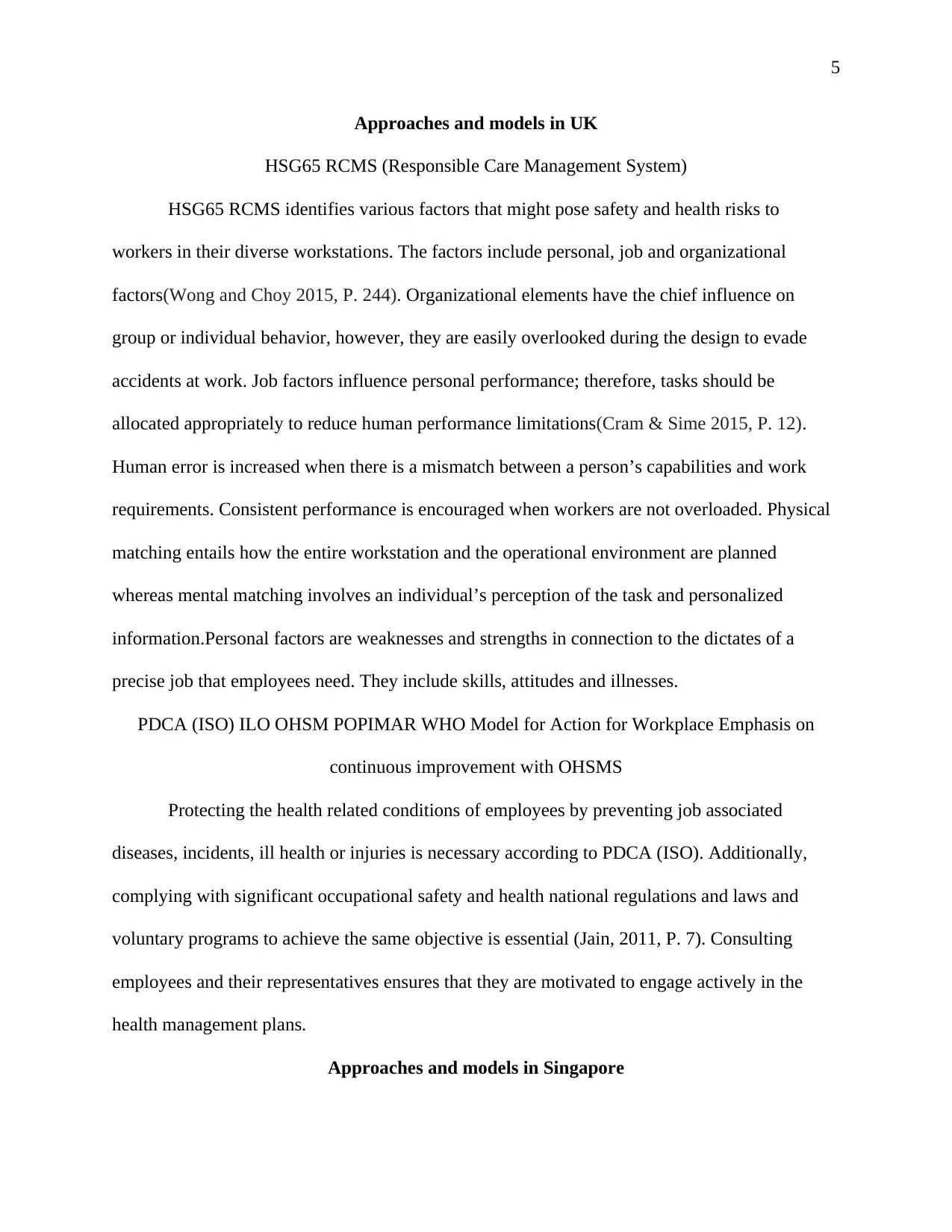
5
Approaches and models in UK
HSG65 RCMS (Responsible Care Management System)
HSG65 RCMS identifies various factors that might pose safety and health risks to
workers in their diverse workstations. The factors include personal, job and organizational
factors(Wong and Choy 2015, P. 244). Organizational elements have the chief influence on
group or individual behavior, however, they are easily overlooked during the design to evade
accidents at work. Job factors influence personal performance; therefore, tasks should be
allocated appropriately to reduce human performance limitations(Cram & Sime 2015, P. 12).
Human error is increased when there is a mismatch between a person’s capabilities and work
requirements. Consistent performance is encouraged when workers are not overloaded. Physical
matching entails how the entire workstation and the operational environment are planned
whereas mental matching involves an individual’s perception of the task and personalized
information.Personal factors are weaknesses and strengths in connection to the dictates of a
precise job that employees need. They include skills, attitudes and illnesses.
PDCA (ISO) ILO OHSM POPIMAR WHO Model for Action for Workplace Emphasis on
continuous improvement with OHSMS
Protecting the health related conditions of employees by preventing job associated
diseases, incidents, ill health or injuries is necessary according to PDCA (ISO). Additionally,
complying with significant occupational safety and health national regulations and laws and
voluntary programs to achieve the same objective is essential (Jain, 2011, P. 7). Consulting
employees and their representatives ensures that they are motivated to engage actively in the
health management plans.
Approaches and models in Singapore
Approaches and models in UK
HSG65 RCMS (Responsible Care Management System)
HSG65 RCMS identifies various factors that might pose safety and health risks to
workers in their diverse workstations. The factors include personal, job and organizational
factors(Wong and Choy 2015, P. 244). Organizational elements have the chief influence on
group or individual behavior, however, they are easily overlooked during the design to evade
accidents at work. Job factors influence personal performance; therefore, tasks should be
allocated appropriately to reduce human performance limitations(Cram & Sime 2015, P. 12).
Human error is increased when there is a mismatch between a person’s capabilities and work
requirements. Consistent performance is encouraged when workers are not overloaded. Physical
matching entails how the entire workstation and the operational environment are planned
whereas mental matching involves an individual’s perception of the task and personalized
information.Personal factors are weaknesses and strengths in connection to the dictates of a
precise job that employees need. They include skills, attitudes and illnesses.
PDCA (ISO) ILO OHSM POPIMAR WHO Model for Action for Workplace Emphasis on
continuous improvement with OHSMS
Protecting the health related conditions of employees by preventing job associated
diseases, incidents, ill health or injuries is necessary according to PDCA (ISO). Additionally,
complying with significant occupational safety and health national regulations and laws and
voluntary programs to achieve the same objective is essential (Jain, 2011, P. 7). Consulting
employees and their representatives ensures that they are motivated to engage actively in the
health management plans.
Approaches and models in Singapore
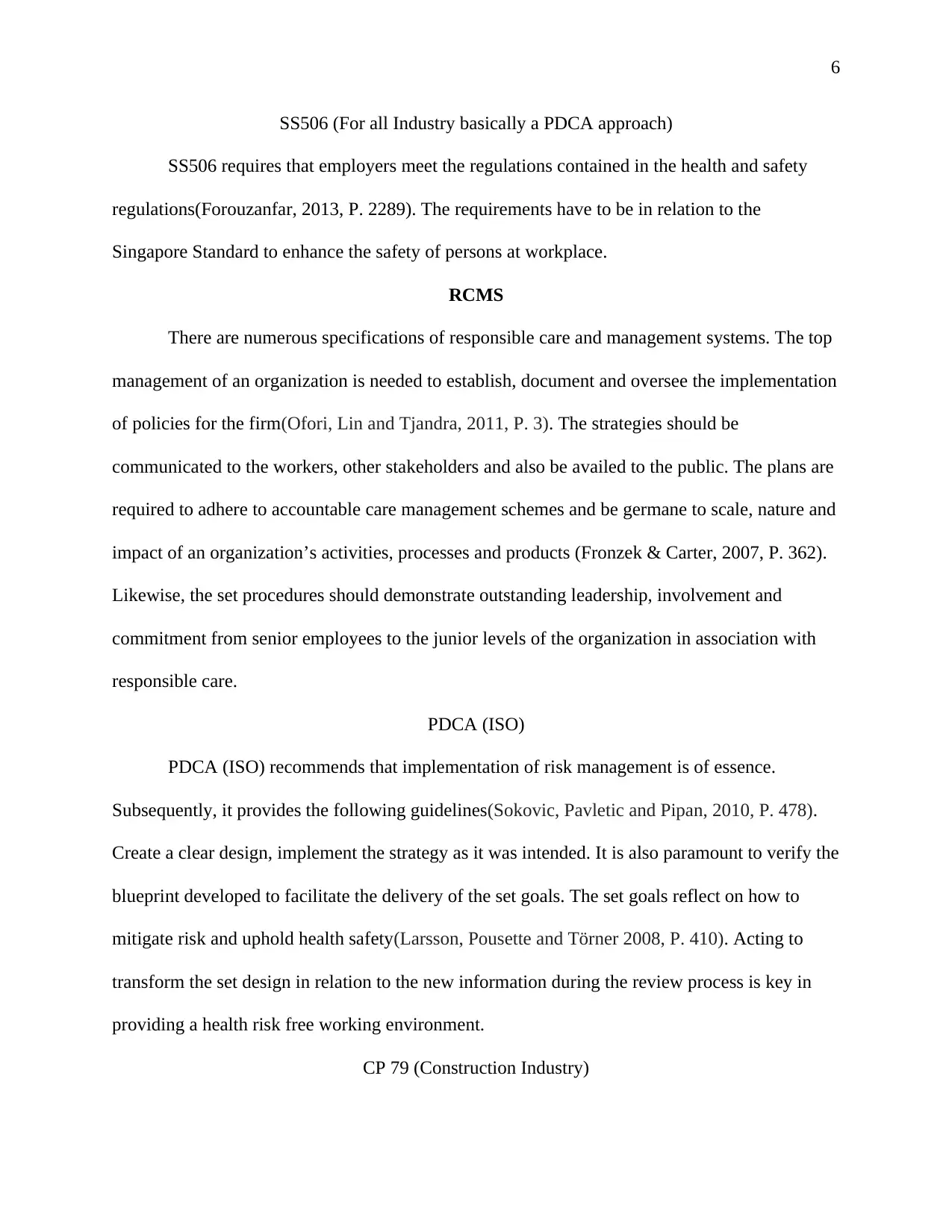
6
SS506 (For all Industry basically a PDCA approach)
SS506 requires that employers meet the regulations contained in the health and safety
regulations(Forouzanfar, 2013, P. 2289). The requirements have to be in relation to the
Singapore Standard to enhance the safety of persons at workplace.
RCMS
There are numerous specifications of responsible care and management systems. The top
management of an organization is needed to establish, document and oversee the implementation
of policies for the firm(Ofori, Lin and Tjandra, 2011, P. 3). The strategies should be
communicated to the workers, other stakeholders and also be availed to the public. The plans are
required to adhere to accountable care management schemes and be germane to scale, nature and
impact of an organization’s activities, processes and products (Fronzek & Carter, 2007, P. 362).
Likewise, the set procedures should demonstrate outstanding leadership, involvement and
commitment from senior employees to the junior levels of the organization in association with
responsible care.
PDCA (ISO)
PDCA (ISO) recommends that implementation of risk management is of essence.
Subsequently, it provides the following guidelines(Sokovic, Pavletic and Pipan, 2010, P. 478).
Create a clear design, implement the strategy as it was intended. It is also paramount to verify the
blueprint developed to facilitate the delivery of the set goals. The set goals reflect on how to
mitigate risk and uphold health safety(Larsson, Pousette and Törner 2008, P. 410). Acting to
transform the set design in relation to the new information during the review process is key in
providing a health risk free working environment.
CP 79 (Construction Industry)
SS506 (For all Industry basically a PDCA approach)
SS506 requires that employers meet the regulations contained in the health and safety
regulations(Forouzanfar, 2013, P. 2289). The requirements have to be in relation to the
Singapore Standard to enhance the safety of persons at workplace.
RCMS
There are numerous specifications of responsible care and management systems. The top
management of an organization is needed to establish, document and oversee the implementation
of policies for the firm(Ofori, Lin and Tjandra, 2011, P. 3). The strategies should be
communicated to the workers, other stakeholders and also be availed to the public. The plans are
required to adhere to accountable care management schemes and be germane to scale, nature and
impact of an organization’s activities, processes and products (Fronzek & Carter, 2007, P. 362).
Likewise, the set procedures should demonstrate outstanding leadership, involvement and
commitment from senior employees to the junior levels of the organization in association with
responsible care.
PDCA (ISO)
PDCA (ISO) recommends that implementation of risk management is of essence.
Subsequently, it provides the following guidelines(Sokovic, Pavletic and Pipan, 2010, P. 478).
Create a clear design, implement the strategy as it was intended. It is also paramount to verify the
blueprint developed to facilitate the delivery of the set goals. The set goals reflect on how to
mitigate risk and uphold health safety(Larsson, Pousette and Törner 2008, P. 410). Acting to
transform the set design in relation to the new information during the review process is key in
providing a health risk free working environment.
CP 79 (Construction Industry)
⊘ This is a preview!⊘
Do you want full access?
Subscribe today to unlock all pages.

Trusted by 1+ million students worldwide
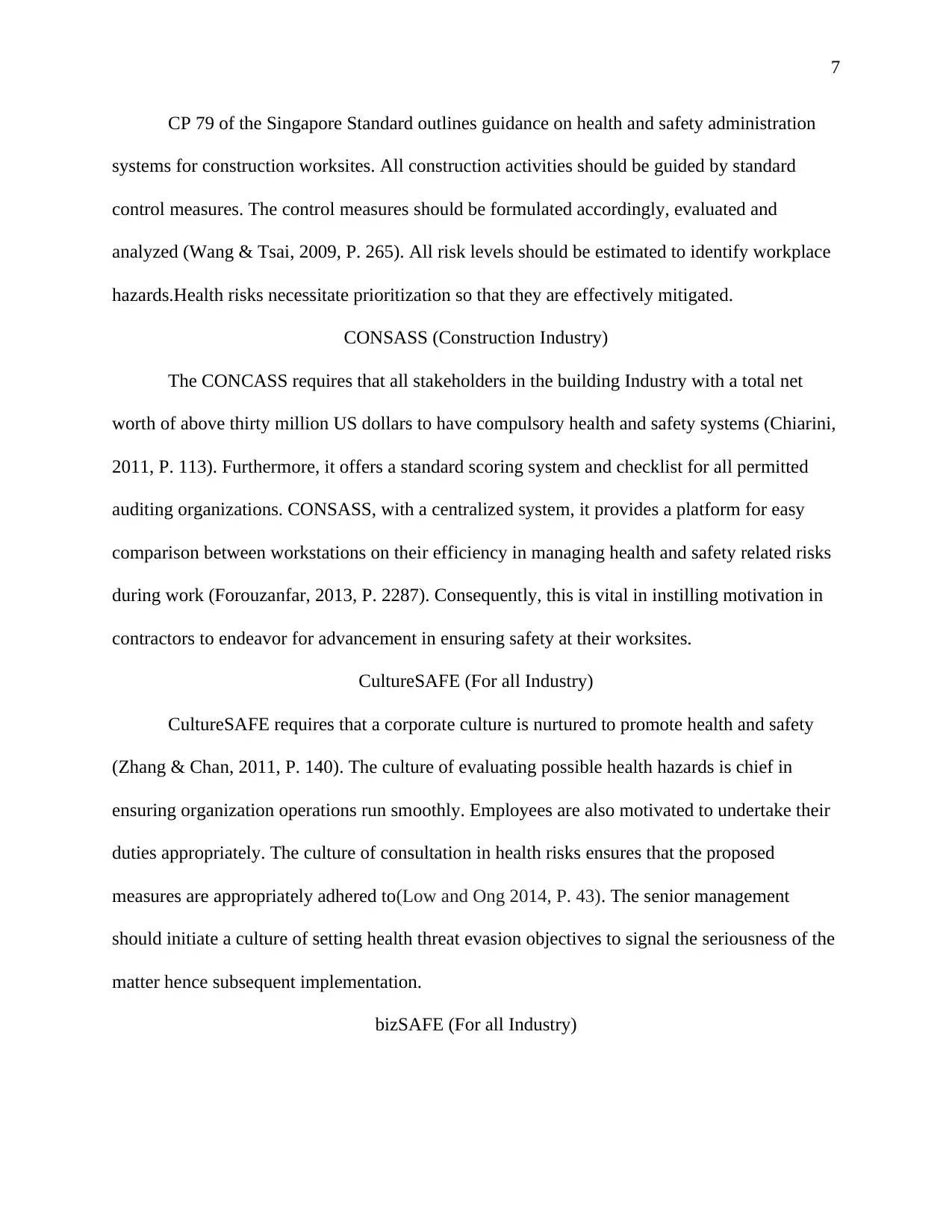
7
CP 79 of the Singapore Standard outlines guidance on health and safety administration
systems for construction worksites. All construction activities should be guided by standard
control measures. The control measures should be formulated accordingly, evaluated and
analyzed (Wang & Tsai, 2009, P. 265). All risk levels should be estimated to identify workplace
hazards.Health risks necessitate prioritization so that they are effectively mitigated.
CONSASS (Construction Industry)
The CONCASS requires that all stakeholders in the building Industry with a total net
worth of above thirty million US dollars to have compulsory health and safety systems (Chiarini,
2011, P. 113). Furthermore, it offers a standard scoring system and checklist for all permitted
auditing organizations. CONSASS, with a centralized system, it provides a platform for easy
comparison between workstations on their efficiency in managing health and safety related risks
during work (Forouzanfar, 2013, P. 2287). Consequently, this is vital in instilling motivation in
contractors to endeavor for advancement in ensuring safety at their worksites.
CultureSAFE (For all Industry)
CultureSAFE requires that a corporate culture is nurtured to promote health and safety
(Zhang & Chan, 2011, P. 140). The culture of evaluating possible health hazards is chief in
ensuring organization operations run smoothly. Employees are also motivated to undertake their
duties appropriately. The culture of consultation in health risks ensures that the proposed
measures are appropriately adhered to(Low and Ong 2014, P. 43). The senior management
should initiate a culture of setting health threat evasion objectives to signal the seriousness of the
matter hence subsequent implementation.
bizSAFE (For all Industry)
CP 79 of the Singapore Standard outlines guidance on health and safety administration
systems for construction worksites. All construction activities should be guided by standard
control measures. The control measures should be formulated accordingly, evaluated and
analyzed (Wang & Tsai, 2009, P. 265). All risk levels should be estimated to identify workplace
hazards.Health risks necessitate prioritization so that they are effectively mitigated.
CONSASS (Construction Industry)
The CONCASS requires that all stakeholders in the building Industry with a total net
worth of above thirty million US dollars to have compulsory health and safety systems (Chiarini,
2011, P. 113). Furthermore, it offers a standard scoring system and checklist for all permitted
auditing organizations. CONSASS, with a centralized system, it provides a platform for easy
comparison between workstations on their efficiency in managing health and safety related risks
during work (Forouzanfar, 2013, P. 2287). Consequently, this is vital in instilling motivation in
contractors to endeavor for advancement in ensuring safety at their worksites.
CultureSAFE (For all Industry)
CultureSAFE requires that a corporate culture is nurtured to promote health and safety
(Zhang & Chan, 2011, P. 140). The culture of evaluating possible health hazards is chief in
ensuring organization operations run smoothly. Employees are also motivated to undertake their
duties appropriately. The culture of consultation in health risks ensures that the proposed
measures are appropriately adhered to(Low and Ong 2014, P. 43). The senior management
should initiate a culture of setting health threat evasion objectives to signal the seriousness of the
matter hence subsequent implementation.
bizSAFE (For all Industry)
Paraphrase This Document
Need a fresh take? Get an instant paraphrase of this document with our AI Paraphraser
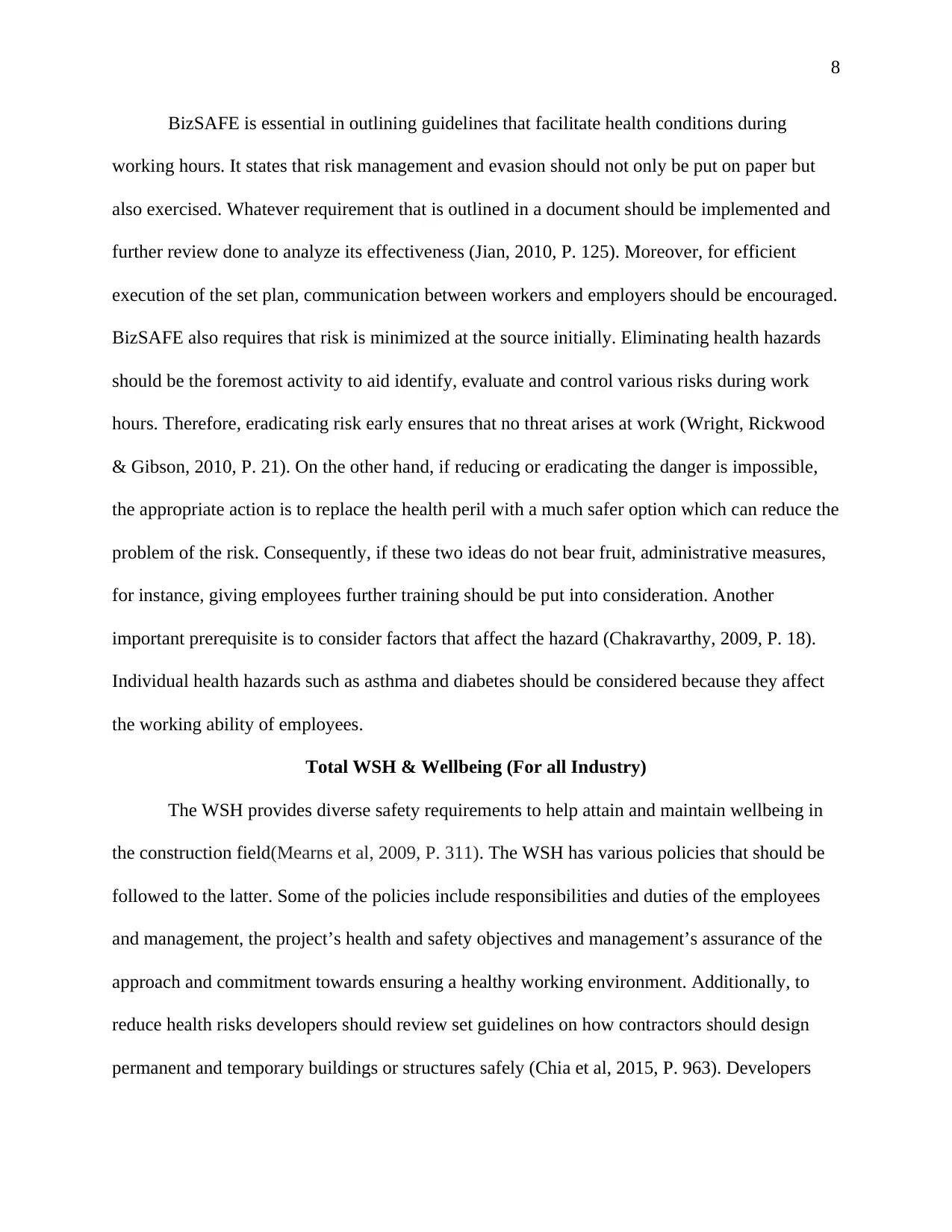
8
BizSAFE is essential in outlining guidelines that facilitate health conditions during
working hours. It states that risk management and evasion should not only be put on paper but
also exercised. Whatever requirement that is outlined in a document should be implemented and
further review done to analyze its effectiveness (Jian, 2010, P. 125). Moreover, for efficient
execution of the set plan, communication between workers and employers should be encouraged.
BizSAFE also requires that risk is minimized at the source initially. Eliminating health hazards
should be the foremost activity to aid identify, evaluate and control various risks during work
hours. Therefore, eradicating risk early ensures that no threat arises at work (Wright, Rickwood
& Gibson, 2010, P. 21). On the other hand, if reducing or eradicating the danger is impossible,
the appropriate action is to replace the health peril with a much safer option which can reduce the
problem of the risk. Consequently, if these two ideas do not bear fruit, administrative measures,
for instance, giving employees further training should be put into consideration. Another
important prerequisite is to consider factors that affect the hazard (Chakravarthy, 2009, P. 18).
Individual health hazards such as asthma and diabetes should be considered because they affect
the working ability of employees.
Total WSH & Wellbeing (For all Industry)
The WSH provides diverse safety requirements to help attain and maintain wellbeing in
the construction field(Mearns et al, 2009, P. 311). The WSH has various policies that should be
followed to the latter. Some of the policies include responsibilities and duties of the employees
and management, the project’s health and safety objectives and management’s assurance of the
approach and commitment towards ensuring a healthy working environment. Additionally, to
reduce health risks developers should review set guidelines on how contractors should design
permanent and temporary buildings or structures safely (Chia et al, 2015, P. 963). Developers
BizSAFE is essential in outlining guidelines that facilitate health conditions during
working hours. It states that risk management and evasion should not only be put on paper but
also exercised. Whatever requirement that is outlined in a document should be implemented and
further review done to analyze its effectiveness (Jian, 2010, P. 125). Moreover, for efficient
execution of the set plan, communication between workers and employers should be encouraged.
BizSAFE also requires that risk is minimized at the source initially. Eliminating health hazards
should be the foremost activity to aid identify, evaluate and control various risks during work
hours. Therefore, eradicating risk early ensures that no threat arises at work (Wright, Rickwood
& Gibson, 2010, P. 21). On the other hand, if reducing or eradicating the danger is impossible,
the appropriate action is to replace the health peril with a much safer option which can reduce the
problem of the risk. Consequently, if these two ideas do not bear fruit, administrative measures,
for instance, giving employees further training should be put into consideration. Another
important prerequisite is to consider factors that affect the hazard (Chakravarthy, 2009, P. 18).
Individual health hazards such as asthma and diabetes should be considered because they affect
the working ability of employees.
Total WSH & Wellbeing (For all Industry)
The WSH provides diverse safety requirements to help attain and maintain wellbeing in
the construction field(Mearns et al, 2009, P. 311). The WSH has various policies that should be
followed to the latter. Some of the policies include responsibilities and duties of the employees
and management, the project’s health and safety objectives and management’s assurance of the
approach and commitment towards ensuring a healthy working environment. Additionally, to
reduce health risks developers should review set guidelines on how contractors should design
permanent and temporary buildings or structures safely (Chia et al, 2015, P. 963). Developers
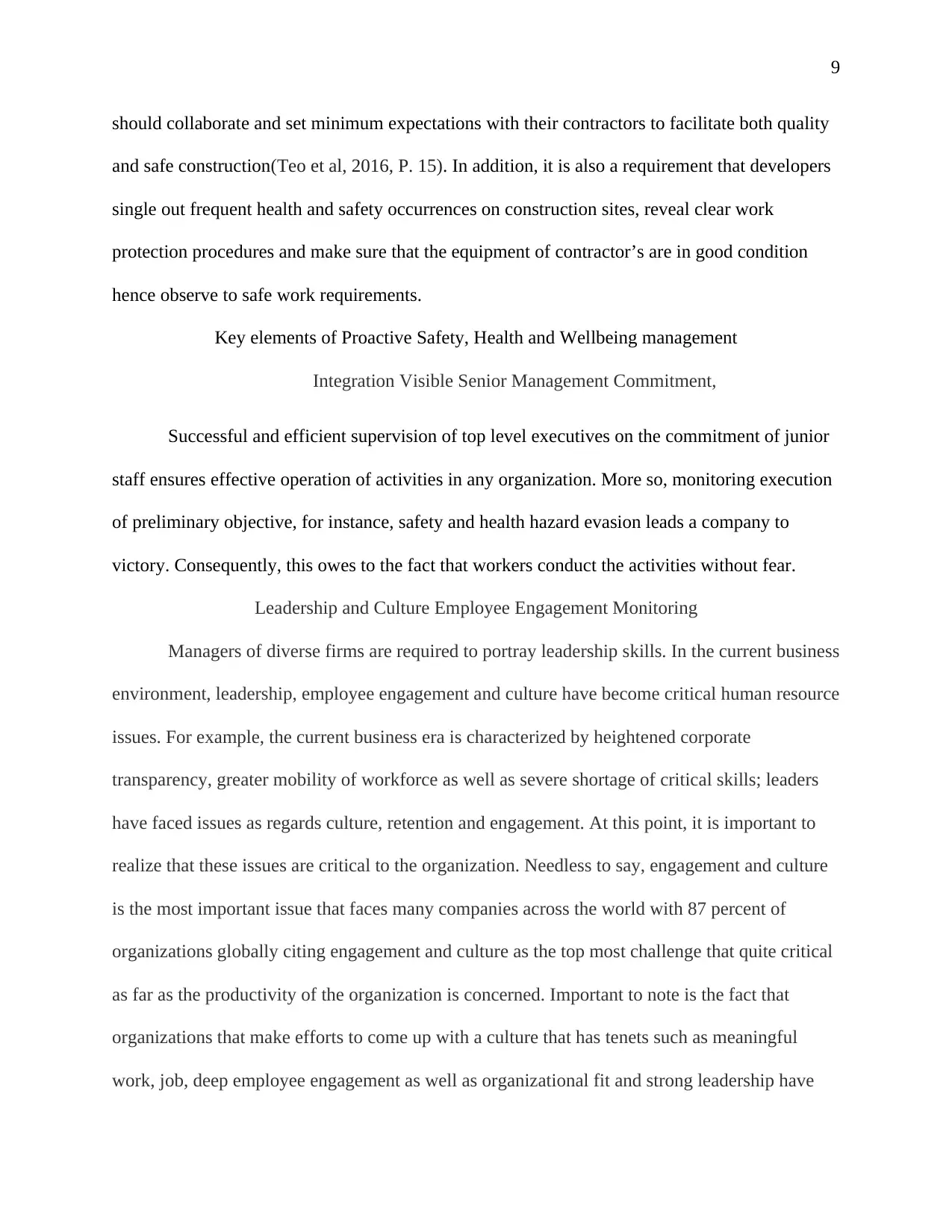
9
should collaborate and set minimum expectations with their contractors to facilitate both quality
and safe construction(Teo et al, 2016, P. 15). In addition, it is also a requirement that developers
single out frequent health and safety occurrences on construction sites, reveal clear work
protection procedures and make sure that the equipment of contractor’s are in good condition
hence observe to safe work requirements.
Key elements of Proactive Safety, Health and Wellbeing management
Integration Visible Senior Management Commitment,
Successful and efficient supervision of top level executives on the commitment of junior
staff ensures effective operation of activities in any organization. More so, monitoring execution
of preliminary objective, for instance, safety and health hazard evasion leads a company to
victory. Consequently, this owes to the fact that workers conduct the activities without fear.
Leadership and Culture Employee Engagement Monitoring
Managers of diverse firms are required to portray leadership skills. In the current business
environment, leadership, employee engagement and culture have become critical human resource
issues. For example, the current business era is characterized by heightened corporate
transparency, greater mobility of workforce as well as severe shortage of critical skills; leaders
have faced issues as regards culture, retention and engagement. At this point, it is important to
realize that these issues are critical to the organization. Needless to say, engagement and culture
is the most important issue that faces many companies across the world with 87 percent of
organizations globally citing engagement and culture as the top most challenge that quite critical
as far as the productivity of the organization is concerned. Important to note is the fact that
organizations that make efforts to come up with a culture that has tenets such as meaningful
work, job, deep employee engagement as well as organizational fit and strong leadership have
should collaborate and set minimum expectations with their contractors to facilitate both quality
and safe construction(Teo et al, 2016, P. 15). In addition, it is also a requirement that developers
single out frequent health and safety occurrences on construction sites, reveal clear work
protection procedures and make sure that the equipment of contractor’s are in good condition
hence observe to safe work requirements.
Key elements of Proactive Safety, Health and Wellbeing management
Integration Visible Senior Management Commitment,
Successful and efficient supervision of top level executives on the commitment of junior
staff ensures effective operation of activities in any organization. More so, monitoring execution
of preliminary objective, for instance, safety and health hazard evasion leads a company to
victory. Consequently, this owes to the fact that workers conduct the activities without fear.
Leadership and Culture Employee Engagement Monitoring
Managers of diverse firms are required to portray leadership skills. In the current business
environment, leadership, employee engagement and culture have become critical human resource
issues. For example, the current business era is characterized by heightened corporate
transparency, greater mobility of workforce as well as severe shortage of critical skills; leaders
have faced issues as regards culture, retention and engagement. At this point, it is important to
realize that these issues are critical to the organization. Needless to say, engagement and culture
is the most important issue that faces many companies across the world with 87 percent of
organizations globally citing engagement and culture as the top most challenge that quite critical
as far as the productivity of the organization is concerned. Important to note is the fact that
organizations that make efforts to come up with a culture that has tenets such as meaningful
work, job, deep employee engagement as well as organizational fit and strong leadership have
⊘ This is a preview!⊘
Do you want full access?
Subscribe today to unlock all pages.

Trusted by 1+ million students worldwide
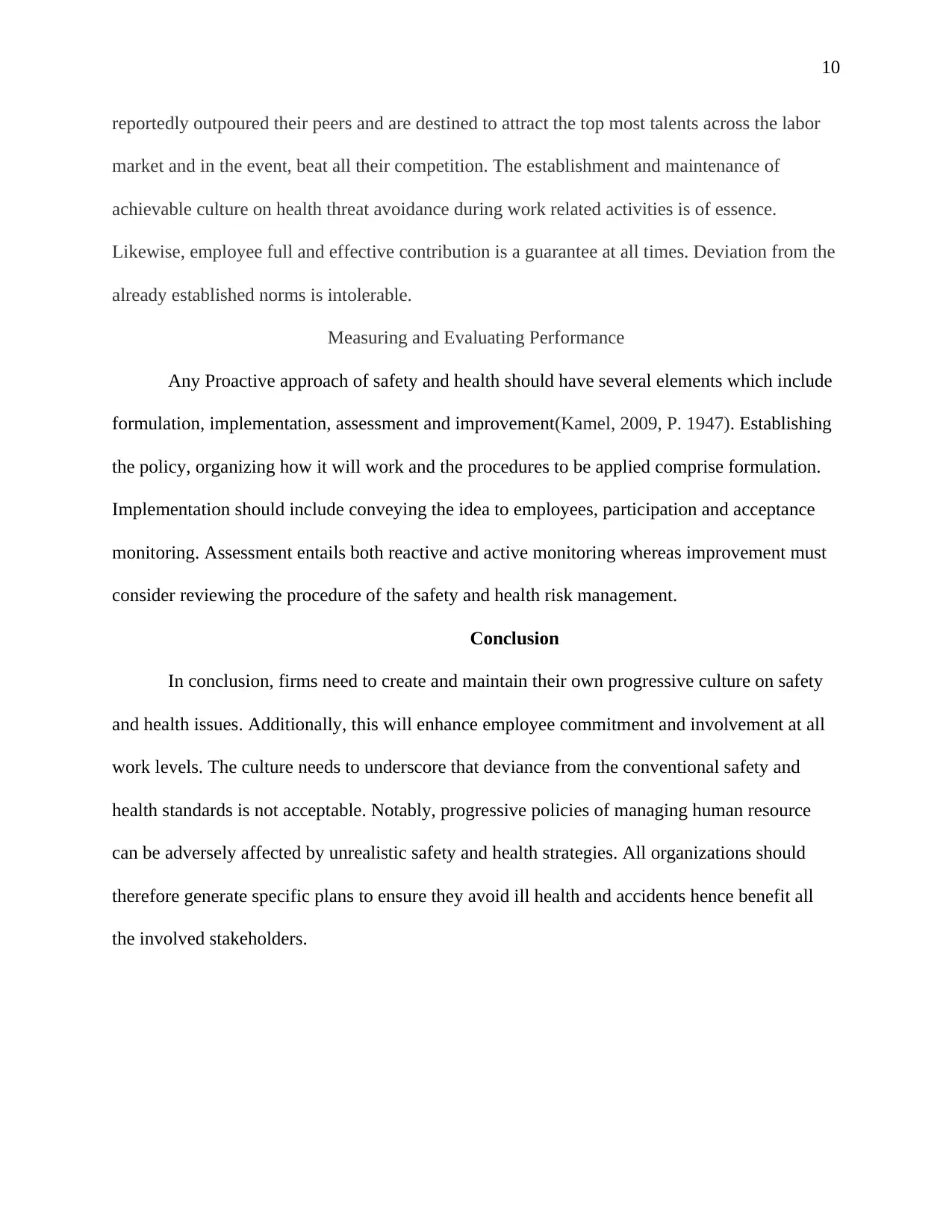
10
reportedly outpoured their peers and are destined to attract the top most talents across the labor
market and in the event, beat all their competition. The establishment and maintenance of
achievable culture on health threat avoidance during work related activities is of essence.
Likewise, employee full and effective contribution is a guarantee at all times. Deviation from the
already established norms is intolerable.
Measuring and Evaluating Performance
Any Proactive approach of safety and health should have several elements which include
formulation, implementation, assessment and improvement(Kamel, 2009, P. 1947). Establishing
the policy, organizing how it will work and the procedures to be applied comprise formulation.
Implementation should include conveying the idea to employees, participation and acceptance
monitoring. Assessment entails both reactive and active monitoring whereas improvement must
consider reviewing the procedure of the safety and health risk management.
Conclusion
In conclusion, firms need to create and maintain their own progressive culture on safety
and health issues. Additionally, this will enhance employee commitment and involvement at all
work levels. The culture needs to underscore that deviance from the conventional safety and
health standards is not acceptable. Notably, progressive policies of managing human resource
can be adversely affected by unrealistic safety and health strategies. All organizations should
therefore generate specific plans to ensure they avoid ill health and accidents hence benefit all
the involved stakeholders.
reportedly outpoured their peers and are destined to attract the top most talents across the labor
market and in the event, beat all their competition. The establishment and maintenance of
achievable culture on health threat avoidance during work related activities is of essence.
Likewise, employee full and effective contribution is a guarantee at all times. Deviation from the
already established norms is intolerable.
Measuring and Evaluating Performance
Any Proactive approach of safety and health should have several elements which include
formulation, implementation, assessment and improvement(Kamel, 2009, P. 1947). Establishing
the policy, organizing how it will work and the procedures to be applied comprise formulation.
Implementation should include conveying the idea to employees, participation and acceptance
monitoring. Assessment entails both reactive and active monitoring whereas improvement must
consider reviewing the procedure of the safety and health risk management.
Conclusion
In conclusion, firms need to create and maintain their own progressive culture on safety
and health issues. Additionally, this will enhance employee commitment and involvement at all
work levels. The culture needs to underscore that deviance from the conventional safety and
health standards is not acceptable. Notably, progressive policies of managing human resource
can be adversely affected by unrealistic safety and health strategies. All organizations should
therefore generate specific plans to ensure they avoid ill health and accidents hence benefit all
the involved stakeholders.
Paraphrase This Document
Need a fresh take? Get an instant paraphrase of this document with our AI Paraphraser
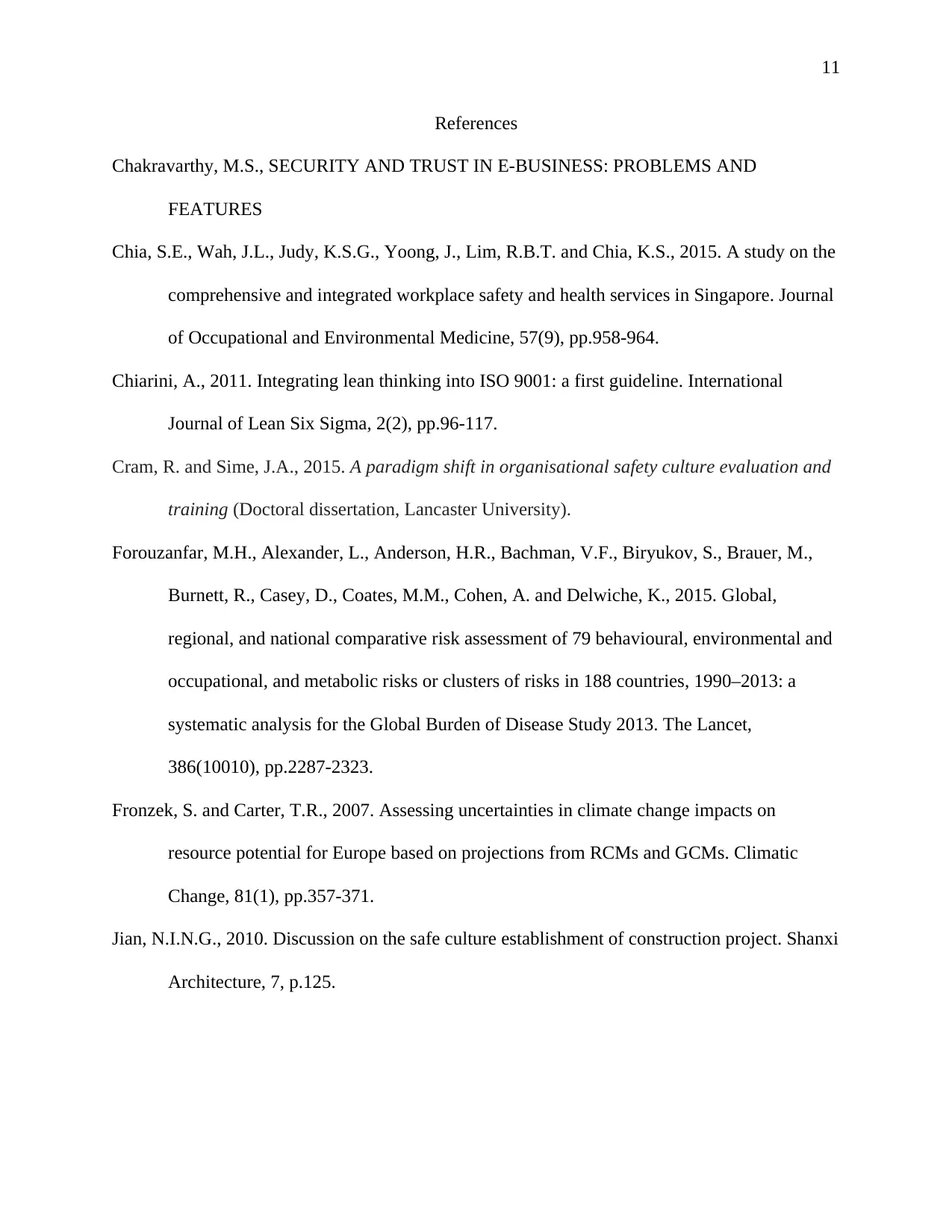
11
References
Chakravarthy, M.S., SECURITY AND TRUST IN E-BUSINESS: PROBLEMS AND
FEATURES
Chia, S.E., Wah, J.L., Judy, K.S.G., Yoong, J., Lim, R.B.T. and Chia, K.S., 2015. A study on the
comprehensive and integrated workplace safety and health services in Singapore. Journal
of Occupational and Environmental Medicine, 57(9), pp.958-964.
Chiarini, A., 2011. Integrating lean thinking into ISO 9001: a first guideline. International
Journal of Lean Six Sigma, 2(2), pp.96-117.
Cram, R. and Sime, J.A., 2015. A paradigm shift in organisational safety culture evaluation and
training (Doctoral dissertation, Lancaster University).
Forouzanfar, M.H., Alexander, L., Anderson, H.R., Bachman, V.F., Biryukov, S., Brauer, M.,
Burnett, R., Casey, D., Coates, M.M., Cohen, A. and Delwiche, K., 2015. Global,
regional, and national comparative risk assessment of 79 behavioural, environmental and
occupational, and metabolic risks or clusters of risks in 188 countries, 1990–2013: a
systematic analysis for the Global Burden of Disease Study 2013. The Lancet,
386(10010), pp.2287-2323.
Fronzek, S. and Carter, T.R., 2007. Assessing uncertainties in climate change impacts on
resource potential for Europe based on projections from RCMs and GCMs. Climatic
Change, 81(1), pp.357-371.
Jian, N.I.N.G., 2010. Discussion on the safe culture establishment of construction project. Shanxi
Architecture, 7, p.125.
References
Chakravarthy, M.S., SECURITY AND TRUST IN E-BUSINESS: PROBLEMS AND
FEATURES
Chia, S.E., Wah, J.L., Judy, K.S.G., Yoong, J., Lim, R.B.T. and Chia, K.S., 2015. A study on the
comprehensive and integrated workplace safety and health services in Singapore. Journal
of Occupational and Environmental Medicine, 57(9), pp.958-964.
Chiarini, A., 2011. Integrating lean thinking into ISO 9001: a first guideline. International
Journal of Lean Six Sigma, 2(2), pp.96-117.
Cram, R. and Sime, J.A., 2015. A paradigm shift in organisational safety culture evaluation and
training (Doctoral dissertation, Lancaster University).
Forouzanfar, M.H., Alexander, L., Anderson, H.R., Bachman, V.F., Biryukov, S., Brauer, M.,
Burnett, R., Casey, D., Coates, M.M., Cohen, A. and Delwiche, K., 2015. Global,
regional, and national comparative risk assessment of 79 behavioural, environmental and
occupational, and metabolic risks or clusters of risks in 188 countries, 1990–2013: a
systematic analysis for the Global Burden of Disease Study 2013. The Lancet,
386(10010), pp.2287-2323.
Fronzek, S. and Carter, T.R., 2007. Assessing uncertainties in climate change impacts on
resource potential for Europe based on projections from RCMs and GCMs. Climatic
Change, 81(1), pp.357-371.
Jian, N.I.N.G., 2010. Discussion on the safe culture establishment of construction project. Shanxi
Architecture, 7, p.125.
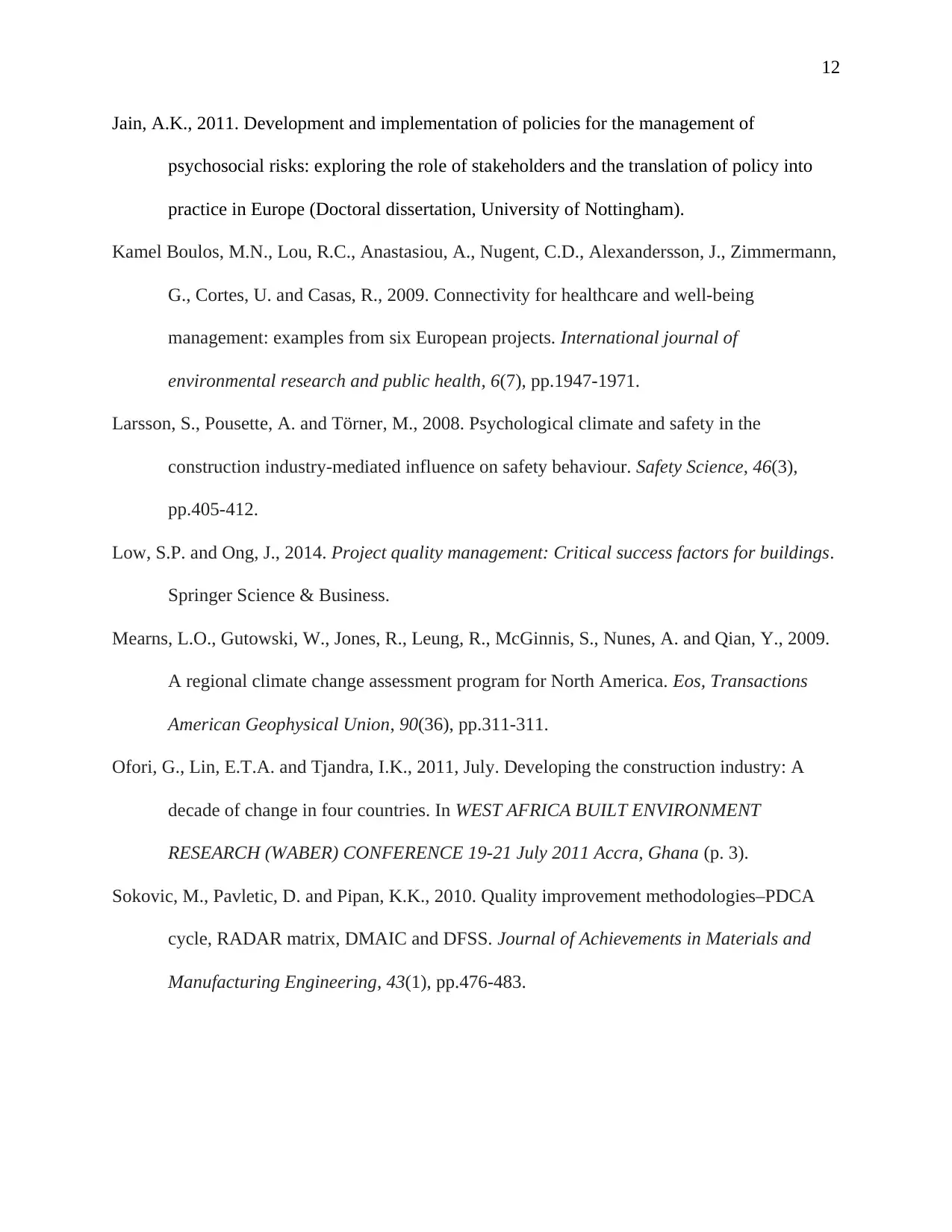
12
Jain, A.K., 2011. Development and implementation of policies for the management of
psychosocial risks: exploring the role of stakeholders and the translation of policy into
practice in Europe (Doctoral dissertation, University of Nottingham).
Kamel Boulos, M.N., Lou, R.C., Anastasiou, A., Nugent, C.D., Alexandersson, J., Zimmermann,
G., Cortes, U. and Casas, R., 2009. Connectivity for healthcare and well-being
management: examples from six European projects. International journal of
environmental research and public health, 6(7), pp.1947-1971.
Larsson, S., Pousette, A. and Törner, M., 2008. Psychological climate and safety in the
construction industry-mediated influence on safety behaviour. Safety Science, 46(3),
pp.405-412.
Low, S.P. and Ong, J., 2014. Project quality management: Critical success factors for buildings.
Springer Science & Business.
Mearns, L.O., Gutowski, W., Jones, R., Leung, R., McGinnis, S., Nunes, A. and Qian, Y., 2009.
A regional climate change assessment program for North America. Eos, Transactions
American Geophysical Union, 90(36), pp.311-311.
Ofori, G., Lin, E.T.A. and Tjandra, I.K., 2011, July. Developing the construction industry: A
decade of change in four countries. In WEST AFRICA BUILT ENVIRONMENT
RESEARCH (WABER) CONFERENCE 19-21 July 2011 Accra, Ghana (p. 3).
Sokovic, M., Pavletic, D. and Pipan, K.K., 2010. Quality improvement methodologies–PDCA
cycle, RADAR matrix, DMAIC and DFSS. Journal of Achievements in Materials and
Manufacturing Engineering, 43(1), pp.476-483.
Jain, A.K., 2011. Development and implementation of policies for the management of
psychosocial risks: exploring the role of stakeholders and the translation of policy into
practice in Europe (Doctoral dissertation, University of Nottingham).
Kamel Boulos, M.N., Lou, R.C., Anastasiou, A., Nugent, C.D., Alexandersson, J., Zimmermann,
G., Cortes, U. and Casas, R., 2009. Connectivity for healthcare and well-being
management: examples from six European projects. International journal of
environmental research and public health, 6(7), pp.1947-1971.
Larsson, S., Pousette, A. and Törner, M., 2008. Psychological climate and safety in the
construction industry-mediated influence on safety behaviour. Safety Science, 46(3),
pp.405-412.
Low, S.P. and Ong, J., 2014. Project quality management: Critical success factors for buildings.
Springer Science & Business.
Mearns, L.O., Gutowski, W., Jones, R., Leung, R., McGinnis, S., Nunes, A. and Qian, Y., 2009.
A regional climate change assessment program for North America. Eos, Transactions
American Geophysical Union, 90(36), pp.311-311.
Ofori, G., Lin, E.T.A. and Tjandra, I.K., 2011, July. Developing the construction industry: A
decade of change in four countries. In WEST AFRICA BUILT ENVIRONMENT
RESEARCH (WABER) CONFERENCE 19-21 July 2011 Accra, Ghana (p. 3).
Sokovic, M., Pavletic, D. and Pipan, K.K., 2010. Quality improvement methodologies–PDCA
cycle, RADAR matrix, DMAIC and DFSS. Journal of Achievements in Materials and
Manufacturing Engineering, 43(1), pp.476-483.
⊘ This is a preview!⊘
Do you want full access?
Subscribe today to unlock all pages.

Trusted by 1+ million students worldwide
1 out of 13
Related Documents
Your All-in-One AI-Powered Toolkit for Academic Success.
+13062052269
info@desklib.com
Available 24*7 on WhatsApp / Email
![[object Object]](/_next/static/media/star-bottom.7253800d.svg)
Unlock your academic potential
Copyright © 2020–2025 A2Z Services. All Rights Reserved. Developed and managed by ZUCOL.





